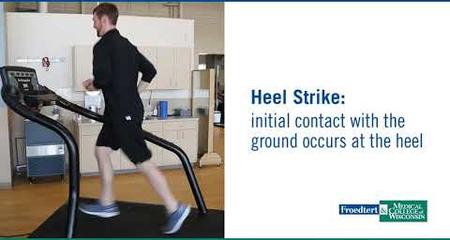Injections are often used in sports medicine to help treat tendon or joint pain, inflammation and impaired mobility. While it is very safe for injections to be done in certain parts of the body, the Froedtert & MCW health network often uses imaging to guide our injections.
Benefits of Ultrasound-Guided Injections
Ultrasound machines allow us to see structures such as tendons, ligaments, muscle and joints in real time for a precise injection delivery. This allows us to safely inject structures in the body that are otherwise difficult to examine and find. It also allows us to avoid important structures such as blood vessels and nerves that may be in the path of the injection needle. It allows our providers to see and avoid potential complications in real-time during the procedure. We use ultrasound-guided injections to ensure our care is optimized for your specific needs.
Using ultrasound also eliminates the risk of radiation. While flouroscopy, a type of real-time X-ray, also allows for visualization during the process, it involves repeated exposure to radiation. Our physicians are using ultrasound to guide pain-relieving hip and shoulder injections instead of fluoroscopy guidance.
Patients experience pain relief and increased function after ultrasound-guided injections. This allows you to return to normal activities sooner. Injections can also be used for pain relief to assist with physical therapy so you can heal and strengthen your injured body part.
Conditions Treated
Ultrasound-guided injections are most commonly used to help treat osteoarthritis, labral tears, tendinitis, tenosynovitis and calcific tendinitis. Injections are also used in the hand, wrist, forearm, elbow, shoulder, AC joint, sternoclavicular joint, hip, knee, ankle, foot and the sacroiliac joint (SI joint) that connects the pelvis and lower spine, in some candidates.
We leverage ultrasound to guide a variety of injection types and orthopaedic procedures:
- Corticosteroids can be injected into joints and tendon sheaths using ultrasound guidance. Ultrasound-guided corticosteroid injections work to get inflammation out of painful areas.
- Anesthetic numbing medications may be used on its own for diagnostic injections and usually in conjunction with corticosteroids for therapeutic injections.
- Hyaluronic Acid is used for lubricating injections into the knee joint. Ultrasound guidance is sometimes used for accurate placement of the injection.
- Tenotomy is an orthopaedic procedure that uses a needle to make tiny holes in a tendon through the skin. The ultrasound machine is used to guide the needling of a tendon to encourage healing.
- Platelet-rich plasma (PRP) injections use ultrasound guidance in the two-step process to reinject platelet-rich blood back into a patient's body to help treat painful conditions such as Achilles tendonitis, chronic hamstring tendonitis, tennis elbow and others.
What to Expect
Ultrasound-guided injections are performed in the office. The injections involve a needle placed through your skin, which can be painful. However, we take care to numb the skin so that pain is minimal. No anesthesia is required. You will be in a room with your provider and usually one other medical care staff member to help with the injection. These injections are done under sterile conditions.
How long does an ultrasound-guided injection take?
An ultrasound-guided injection normally takes between 20 and 40 minutes. If you get nervous about injections, please let your provider know prior to your appointment.
What are the side effect and risks?
Anytime a needle is inserted into the skin, there is a chance of bleeding and infections. However, the overall risk for injections are very low. We take great precautions to prevent these things from happening by using sterile techniques and avoiding blood vessels by using ultrasound imaging.
In very few cases, corticosteroids can flare up the pain prior to it helping. This happens in less than 1% of patients. Sometimes if a very superficial structure is injected, steroids can get into the skin and lighten that area.
How long do patients take to recover?
The anesthetic in the injection will take effect approximately an hour after it is injected. Corticosteroids can take 2-3 days to start working and up to 14 days for its full effects. Recovery depends on the extent of your orthopaedic issue. Your provider will discuss your expected recovery time with you.
Your provider will indicate your activity modifications after injections. Typically, it is okay to drive after these injections. If corticosteroids are injected near a tendon, you will be asked to avoid heavy lifting or strenuous activities for five days. If corticosteroids are injected into a joint, you will not have strict activity modifications.
How often can injections be repeated?
Corticosteroid injections can be repeated 3-4 months after the initial injection however, should be limited to 2-3 times per year. In some cases, we will limit the number of injections even further.
Are injections covered by insurance?
Typical insurance coverage of various ultrasound-guided injections are listed below. It is always recommended to check with your insurance prior to having any type of procedure or injection.
- Corticosteroids are covered by insurance.
- Hyaluronic acid knee injections are usually covered by insurance.
- Prolotherapy is usually not covered by insurance.
Is an Ultrasound-Guided Injection Right for Me?
Your provider will determine if injections are appropriate for your specific orthopaedic condition. Your doctor may also recommend ultrasound guidance for injections in in pediatric patients.
There may be a few injection types that should be avoided for certain patients. In general, those with uncontrolled diabetes should refrain from corticosteroid injections. If you have diabetes, you may be asked to keep a close eye on your blood sugars as there is a small chance the steroid can bring your blood sugar numbers up. If you are preparing for a surgery, your surgeon will not want corticosteroids injected into the same area before the surgery. Ask your provider for more information.
Talk to your doctor to learn more about ultrasound-guided injections and if it might be the right treatment for you.
More to Explore





